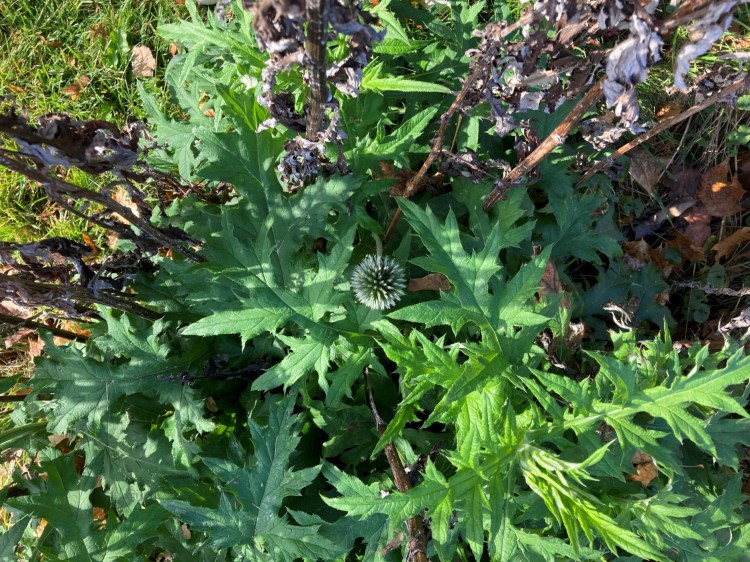When I was weeding our strawberry bed on Halloween, I found many of the plants in blossom, several with tiny green strawberries and one almost-ripe strawberry.
These aren’t so-called ever-bearing strawberries, which produce one crop in June and another later in the season. These are Sparkles, a traditional Maine variety that is supposed to produce fruit in late June and early July. This year, because of the early spring, ours provided no fruit after June 30.

Stella D’Oro daylilies (and a bellflower) blooming in a Portland garden on Oct. 25. Fall lingers warmer and longer in Maine.
By Nov. 1, our garden had had one light frost, damaging the tenderest of the annual flowers but letting others – some zinnias and most but not all of the dahlias – survive. This is the latest we have ever gone without a killing frost in our Cape Elizabeth garden. The earliest ever was Sept. 20, several decades ago.
Strawberries are not the only repeat blooms. It has happened with some globe thistle, azaleas, forsythia and other plants that have their prime blossoming season in the spring but develop buds for the next year’s blossoms over the summer and autumn.
The longer growing season – and maybe the stress of the hot, dry summer – triggers these plants to put out late blooms. The blossoms for one year won’t threaten the health of your plants for future years.
Like much of the rest of the world, Maine has been warming for decades. Maine’s state climatologist Sean Birkel, who is affiliated with both the University of Maine Cooperative Extension and the Climate Change Institute, defined “climate” as weather over a long period of time.
“Since 1998, Maine has seen a string of particularly warm years,” Birkel said in a telephone interview, directing me to the interactive Maine Climate Office website, which shows how much the state’s temperature have changed since 1895.
Since 1998, temperatures have averaged three degrees higher than the previous averages. The warmest year was 2010, with 4.5 degrees over the base; the second warmest was 2021, at 4.1 degrees warmer. Much of the increase has come in the winter, Birkel said. Checking winter temperatures on the climate office website, I can see, for instance, that the winter of 2016 was 8.8 degrees warmer than the average.
The late blossom on plants may be more dependent on the length of the growing season, the dates from the last hard frost in the spring to the first frost in the fall. Another chart on the website shows that the growing season has increased by more than two weeks, 15.7 days, since 1950, with more of the increase coming in the autumn (9.1 days) than in the spring (6.7 days). It isn’t a guarantee, though. In 2018, late frosts in May and early frosts in September knocked the growing season back to its 1950 length.
This winter, when I have more time to read, I am going to tackle the climate update that Birkel’s office published in 2021.

Calendula blooming in a Portland garden on Nov. 6. Photo by Peggy Grodinsky
All of this information on warming temperatures made me wonder about hardiness zones. The U.S. Department of Agriculture Plant Hardiness Zone Map was last updated in 2012, based on climate data from 1976 to 2005. According to the USDA website – I couldn’t reach a live human – that map was about half a zone warmer than the previous edition, which came out in 1990 based on data up to 1986. Had I reached a human, I would have asked if a new map is in the works. Given the the increased rate of warming, according to climatologists, and the 12-year gap between the previous editions — it has now been 10 years since the latest one — it seems likely. The zones on the map are based on the coldest temperature of the year, rather than the average temperatures. It must be that extreme cold is what kills plants.
There are other options, though. The American Horticulture Society uses heat zones, based on the number of days that the temperature exceeds 86 degrees Fahrenheit. That scale is of more use to gardeners in the South. An Arbor Day Foundation map closely follows the USDA map, and a Sunset Zone map is only for Western states.
What does this data mean for me as a person and gardener?
Well, as a person, I know that warmer winter temperatures are harmful for the earth and the plants and animals on it, but I will enjoy the likely lower heating oil use this winter.
And I might start buying a few Zone 6 plants.
Tom Atwell is a freelance writer gardening in Cape Elizabeth. He can be contacted at: tomatwell@me.com.
Copy the Story LinkSend questions/comments to the editors.



Success. Please wait for the page to reload. If the page does not reload within 5 seconds, please refresh the page.
Enter your email and password to access comments.
Hi, to comment on stories you must . This profile is in addition to your subscription and website login.
Already have a commenting profile? .
Invalid username/password.
Please check your email to confirm and complete your registration.
Only subscribers are eligible to post comments. Please subscribe or login first for digital access. Here’s why.
Use the form below to reset your password. When you've submitted your account email, we will send an email with a reset code.